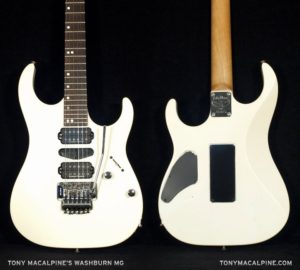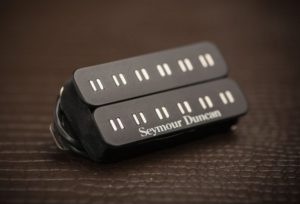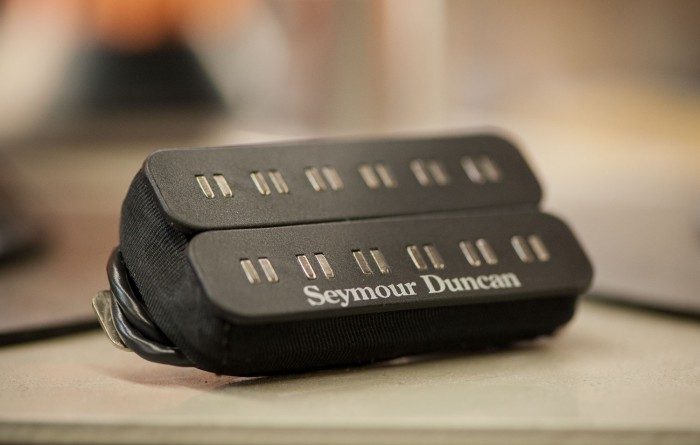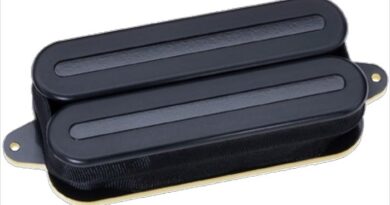Seymour Duncan Parallel Axis Original Set

Who else remembers the first time they saw the trippy design of the Parallel Axis pickups? For me, it was seeing them in Tony MacAlpine’s Washburn MG in 1993. And it did, in fact, only have the neck and bridge humbuckers. Not only did Tony introduce me to Zakk Wylde that weekend, he also facilitated my first meeting with the man: Seymour Duncan.
Tony was also an influence in checking out the DiMarzio MegaDrive DP107 humbucker, which he had in his Mason Bernard “Standard” model and in his BC Rich guitars. These days, Tony is a little more known for his 7 and 8-string EMG pickups. More stories about T Mac another time.
Technically speaking, the Parallel Axis is seen in the 1988 Seymour Duncan catalog. There it goes by Trembucker. The late 1980s is about the time all the “trem” spacing variation start up. It can stand to reason that the name change is to avoid confusion.
Looking at the Parallel Axis design, you obviously notice pairs of staple poles on each bobbin for each string. 12 poles per bobbin. 24 per humbucker. Doesn’t that many poles remind you about some of the Carvin (er, I mean Kiesel) pickup options. LOL!
Think of it a little like this. Your garden variety pickup has a pole piece right under the string, in most cases. That’s a magnetic source right under your string, affecting how much the string vibrates. And that’s all part of how a pickup works and it’s totally normal by currently accepted standards. So imagine these staple poles on either side of each string in parallel (hence the name!).
The regular Parallel Axis bridge pickup is spaced 53mm from E to E. Just check your guitar’s spacing before moving forward. I’d not typically care too much about pole spacing, but the nature of the Parallel Axis pole design is a different beast. The neck model is standard spacing.
Something to keep an eye on if you choose to try the Parallel Axis design is the pickup height. There is a sweet spot in between those staple poles. Imagine the graphs you see of a magnetic field and how its balloons out. You normally have 6 of those on each bobbin of a regular pickup – one under each string. But on the Parallel Axis design, there is one magnetic field on each side of each string. The goal is to find the position to where the staple poles are working in a bit of a push and pull. Seymour’s approach is that such a give and take works toward that longer sustain. Just tinker with some small adjustments and let your ears guide you.

Having 4-con lead wire out of the box, this set is installed in a double hum guitar with series/split/parallel options for each pickup. Once in a guitar, you have to admit that the look of the Parallel Axis is pretty cool.
The Parallel Axis Original bridge packs plenty of drive to make it a solid rock machine. Lows have a little focus without being brittle, so you get more deliberate chugging on those pedal note riffs. The high end sings with an edgy sweetness that has bite without being shrill. The mids are fairly even and smooth across the range. I think it’s the mids that set this pickup apart, so let’s look at that. I think it is what makes this a good option for people that think the JB has too much and the Custom Five has too little.
Moving to the Parallel Axis Original neck, let me throw in a disclaimer. I am using one of the older models made by MJ on the production floor. There’s a growing consensus that the ‘stamped label’ is the Golden Age of the Duncan offerings and I am inclined to agree. The Parallel Axis Original neck would have to go on my Top 5 list of neck pickups offered by the Duncan company. Precision in the low end to avoid mud. The upper mids and the high end are more about clarity, so notes are more precise and less nasal on the high end.
In what could be a genuine travesty, I cannot find any authorized video or sound clips of the Parallel Axis Original set. Someone needs to get on top of that! Don’t want to let the wheels fall off that wagon. HaHa!
In the meantime, you always know that I have some specs:
Series – 16.198 K
Inductance – 9.709 H
North – 7.974 K
South – 8.259 K
Parallel – 4.052 k
Resonant Peak – 4.5 KHz (advertised)
Magnet – Alnico 5
Series – 7.324 K
Inductance – 4.132 H
North – 3.683 K
South – 3.632 K
Parallel – 1.8285 k
Resonant Peak – 6.9 KHz (advertised)
Magnet – Alnico 5
The Parallel Axis Original set is versatile set that is good for everything from heavy blues to metal. This would be a set to look into if you’re considering a little more clarity and sustain. There are other options on the Parallel Axis menu for extreme and for old-school.
For reference, this Parallel Axis Original pickup set evaluation was conducted with a Fractal Axe-Fx II XL+ featuring Celestion Impluse Responses and Fractal MFC-101 MIDI Foot Controller. Real cabs used were Marshall 1960B cabs loaded with Celestion G12-65s, Vintage 30s and G12M Greenbacks.
Seymour Duncan Website | Facebook | Twitter | YouTube | Instagram




